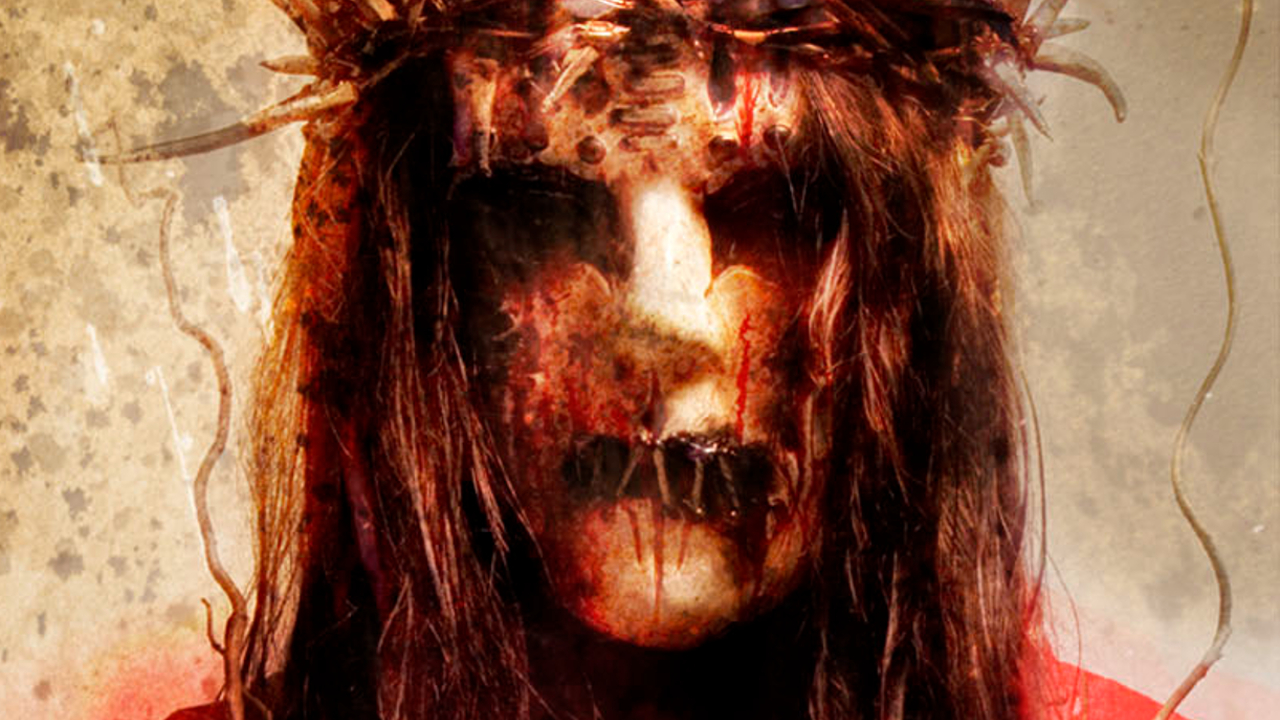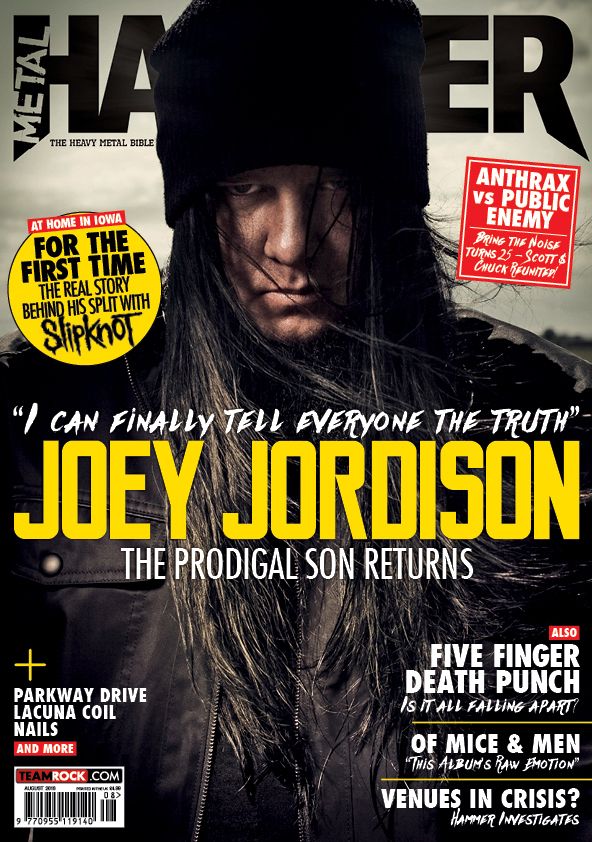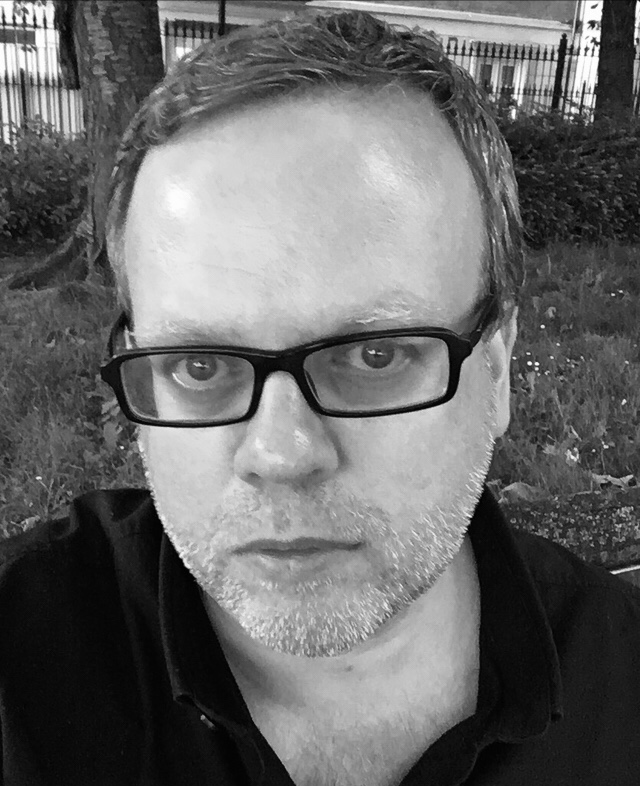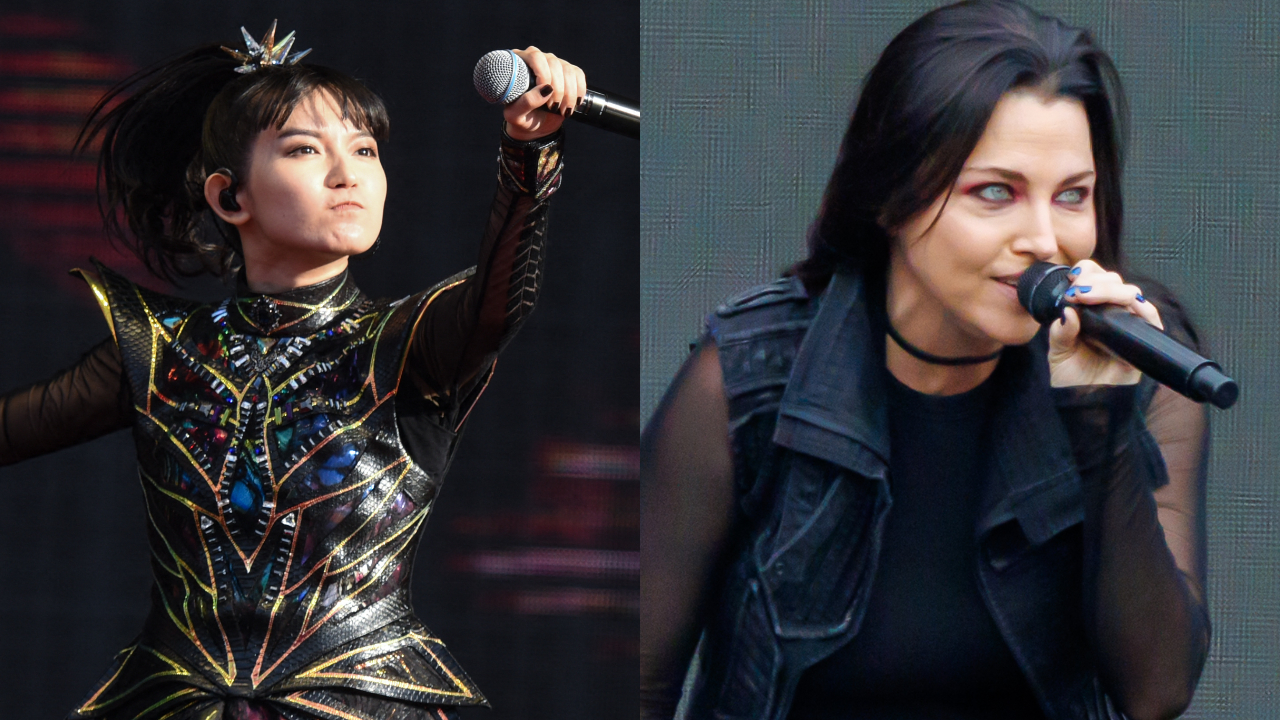"He was one of the best drummers the metal world has ever seen." The wild life, incredible career and tragic end of Slipknot legend, Joey Jordison
On July 26, 2021, the metal world lost Slipknot icon Joey Jordison. This is the story of his life and legacy, as told by those who knew him best

Joey Jordison liked to tell people that his very first memory found him alone, locked up, in darkness.
“I don’t know if I had conscious thoughts while I was in the womb, but I was in a black cell,” he recalled. “Looking up in the corner, I could see a tiny square window, letting in a little bit of light. That was it.”
The story fed neatly into the narrative constructed around Slipknot in the dying days of the 20th century. Here was America’s worst nightmare: a collective of alienated, isolated, frustrated sociopaths emerging from society’s shadowy margins on a mission to destroy everything pure and sacred, to create and embrace chaos, to unleash hell on earth.
They wore masks to protect their anonymity, dressed identically in barcoded red coveralls to remove all trace of ego and individual personality, and self-identified by numbers rather than names to eradicate personal histories and unshackle themselves from any inhibiting loyalty to family, community, church or state. Terrifyingly, these faceless freaks could be anyone, and now they were among us, inside us.

“Fuck it all, fuck this world, fuck everything that you stand for”, sang ‘#8’ on Surfacing, the signature liberation anthem on their self-titled Roadrunner Records debut. “Don’t belong, don’t exist, don’t give a shit! Don’t ever judge me.”
On May 27, 1999 this writer became the first UK music journalist to see Slipknot face-to-mask, on the opening date of that summer’s Ozzfest tour, in West Palm Beach, Florida. Their mid-afternoon set on the festival’s second stage was exhilarating and terrifying in equal measure, a violent, cathartic explosion of hate, venom and rage that left the audience awed and electrified. Instinctively aware that here was a band like no other, myself and veteran rock photographer Ross Halfin cautiously approached The Nine as they walked offstage. Never easily impressed, Ross demanded to know where the group hailed from. Hearing the response, “Des Moines, Iowa”, the well-travelled photographer sneered, “That place is a shithole.”
“We know,” came the instant reply from within the huddle. “That’s why we formed this band.”
Sign up below to get the latest from Metal Hammer, plus exclusive special offers, direct to your inbox!
You stick nine guys together who have had no outlet for their whole lives, and you live in Iowa and you come out on a fucking stage, then you have some shit to portray. We were walking around like ghosts, slitting our wrists open saying, ‘Please take a look at this, look at what we are trying to do.’”
With these words, Slipknot member ‘#1’, AKA Nathan Jonas ‘Joey’ Jordison, introduced himself to the readers of Metal Hammer in the spring of 1999. Speaking to this writer more than a decade later, the drummer’s memories of seeing his band in the magazine for the first time were still vivid, and he shared them in excitable, high-pitched, rapid-fire bursts.
“It was an introductory two-page feature with a picture of us down on Santa Monica Pier: we had our red coveralls on, the sky was blue and you could see the Ferris wheel behind us,” he recalled with perfect clarity. “I remember getting the magazine around May 25 as we were leaving Des Moines to go down to Florida for our first show on the Ozzfest, and I was like, ‘Let me see it! Let me see it!’ I remember passing it around the bus, thinking, ‘We’re in Metal Hammer, we’re on a tour bus, and we’re going to play fucking Ozzfest!’ It was like it just couldn’t get any better than that. It was just one of those moments, a really great memory. I was thinking, ‘Holy shit, we have arrived!’”
In truth, for the then-24-year-old drummer, Slipknot’s journey into the darkness had only just begun.
By the summer of 2003, when Metal Hammer writer Dave Everley sat down with the drummer to harvest his personal reflections and recollections of that journey, Joey Jordison was one of the most recognisable rock stars in the world, whether masked or unmasked - the drummer having set aside his trademark blank ‘spooky Kabuki’ mask when launching his horror-punk side band Murderdolls with Frankenstein Drag Queens From Planet 13 frontman Wednesday 13 the previous year, during Slipknot’s first real time-out since their ferocious, feral 1999 breakthrough album.
Such was Slipknot’s impact in those four pivotal years, a period in which they comprehensively redefined the shape and sound of modern metal, that it’s possible to forget just how far outside the margins they once proudly stood. To a large extent, in fact, it was Shawn ‘Clown’ Crahan’s almost maniacal commitment to making uncompromising outsider art that first attracted Joey Jordison to join the band, then still operating as The Pale Ones, in the summer of 1995: “I knew we were going to fuck people up,” he would later recall.
From day one, the drummer began augmenting and amplifying Shawn’s vision. It was Joey who created the band’s logo, who took a pivotal role in designing their visual aesthetic, who coined the affectionate term ‘Maggots’ for their swelling, fiercely loyal and increasingly unhinged fanbase. Each night, Shawn would join his livewire sidekick at the petrol station where Joey worked, and the pair would talk ’til daybreak, plotting out the roadmap which they hoped would facilitate their escape from Des Moines and lead on to inevitable world domination.
By the time Roadrunner Records A&R chief Monte Conner became sufficiently intrigued by the word-of-mouth buzz on the still-coalescing project, Slipknot effectively had three frontmen in their ranks: the newly recruited, and seriously twisted pretty boy singer Corey Taylor; conceptual visionary Shawn Crahan; and tireless hype man Joey Jordison. Of the three, however, it was the effervescent Joey – by now known to his bandmates by the nickname ‘Superball’ due to his relentless energy - who made the biggest first impression on the industry vet when, in April 1998, Monte first saw Slipknot live, at a showcase gig the band’s manager at the time had set up at the McCormick Auditorium on the campus of the Illinois Institute of Technology in Chicago.
“Joey pulled me aside as soon as I got backstage,” Monte tells Hammer. “All he wanted to talk about was metal. Not business but just metal. Joey’s encyclopaedic knowledge of underground metal as well as the history of Roadrunner Records just blew me away. This was a person who spoke my language, and we could have stood there and talked for hours. He had a manic energy and excitement in his eyes that convinced me that he had the passion, belief and commitment to make Slipknot a groundbreaking force. His long-term vision was that he wanted Slipknot to be the biggest metal band on the planet.”
“Slipknot is not just music, it’s a force, it’s a lifestyle,” the evangelistic Joey insisted, demanding unwavering loyalty to the cause as the legions of Maggots swelled.
“It didn’t happen overnight, because we had to work so hard for it but… it happened overnight! We went on Ozzfest, and three weeks into it we’d sold 150,000 records. Every time we played, everybody – every fucking band, Black Sabbath included – was out there watching us. And we’re out for blood, we fucking hate everybody, just ‘Fuck you!’ That’s always been the Slipknot mentality. We love a lot of other bands, we love a lot of different music, but when it comes to us playing, we just don’t care. It’s your ass. People think it’s arrogant, and it is. We believe in our craft. We believe in Slipknot.”
“I remember Bruce Dickinson saying, ‘I don’t wake up and say, I’m the singer in Iron Maiden’,” he added. “Well, I do wake up and fucking say, ‘I’m the drummer in Slipknot.’”
Joey Jordison originally chose his trademark look as a throwback tribute to a memorable Halloween night in the mid-80s when his mother Jackie lunged at him wearing an identical white mask, and “scared the fucking shit” out of her eldest child. The prank was an illustration of the tight relationship between Joey and his mother, who initiated her boy’s lifelong love of music by sitting him in front of the family stereo rather than TV set whenever she had to attend to his two younger sisters.
“I latched onto music at a young age and it was all I cared about,” Joey later remembered. “I was a day-dreamer, thinking about these larger than-than-life possibilities that could happen if I worked hard.”
When Joey wasn’t found singing along to his parents’ vinyl collections, Jackie Jordison would inevitably locate her livewire toddler in the kitchen, gleefully thumping pots and pans with wooden spoons: “I thought he had a heck of a beat for a little, tiny kid,” she later recalled. One day, when Joey was eight, he returned from school to find his parents sitting at the kitchen table. “Go downstairs and get my Elton John record,” his mum told him. “We’re having an argument about one of the songs.” The boy trudged down to the basement and found a drum kit set up in the middle of the room. Stunned by the discovery, it took him a minute or two to compose himself and locate the album his mum had asked for. When he handed it over, his mum laughed and said, “Joey, I didn’t need the record. Go!” The words had barely left her lips before she heard cymbals crashing and thumping beats.
“From that point on,” Joey said, referring to the moment as an ‘epiphany’, “my life changed.”
But not in every way. Two decades on, when Dave Everley caught up with the drummer, Joey was still living at home with his mom in the same house.
“I like the quiet,” he said, a comment that carried a certain irony. “I like getting away from the busy streets and the noise and the chaos. It’s nice to go home to some peace and quiet, ’cos there’s none of that on the road.”
Asked by Dave to name his greatest obsession, Joey replied, “music”. Asked how he switched off from music, the drummer looked puzzled.
“What do you mean?” he said.
“Do you ever stop thinking about music?” Dave enquired.
Again, Joey looked confused.
“No,” he answered, as if this was the weirdest question he’d ever faced in his life. “It’s the only thing I know how to do well. I can spin upside down on a drum riser in front of 20,000 people with Slipknot, but I can’t go to the mailbox and figure out my mail. I have no sense of normal reality at all.”
In truth, real life lost its appeal for the drummer around the time that his father walked out of the Jordison family home in Waukee, Iowa: “All of a sudden,” he recalls, “I had to be the man of the house, in a weird way. It turned me into a more mature person at a really young age.”
Kiss, Iron Maiden and Black Sabbath offered Joey escapism from the daily grind, while Keith Moon, John Bonham and Peter Criss became the boy’s substitute male role models. Later, Metallica’s Lars Ulrich and Slayer’s Dave Lombardo would provide both challenges and inspiration.
“Without Metallica I wouldn’t be doing what I am doing,” Joey once acknowledged. “Led Zeppelin and The Who passed the torch to Metallica, they’re that band for our generation. I have every Metallica record of course, and I would spend hours on drums in my parents’ basement, with the stereo behind me, cranking those records and learning Lars’s drum beats, beat by beat. Nowadays, for me, Metallica can do whatever the fuck they want.”
Wednesday 13 tells a brilliant story that paints a wonderful picture of his Murderdolls bandmate as a wide-eyed Metallica fanboy. The date was June 1, 2003, and having played the opening day of the inaugural Download festival at Donington Park, Murderdolls decided to stick around for day two, partly because they’d heard whispers that Metallica were set to make an unbilled mid-afternoon appearance on the site’s second stage. Wednesday 13 uses the word “crazy” when recalling the day, remembering his band “running round drinking, partying and getting kinda loose.” All fun and games until the singer lost his pals, and realised he had no idea where the Murderdolls bus was parked up.
“This is before the days of cell phones, so I was in real trouble,” he tells Hammer. “I’m walking around and suddenly I see this bus pull up next to me…”
The bus door swings open, and to Wednesday’s astonishment, out steps Kirk Hammett, Lars Ulrich and Robert Trujillo, fresh from his UK debut with Metallica.
“They go, ‘Hey! You played with Joey, right?’ And I go, ‘Yeah!’ And they go, ‘Where is he?’ And I tell them I don’t know, that I’ve lost my bus. And Lars says, ‘Come on, hop in and we’ll go find him!’ So, I’m sitting there… on Metallica’s bus! They start driving around and eventually find the Murderdolls bus.
“I go up on to the top deck and the band are all sitting there glaring at me. Joey’s sitting there in the back lounge and he looks at me and shouts, ‘Dude! Where the fuck have you been! We’re gonna be late for our show tomorrow!’ And I’m just smiling at him, and I go, ‘Well… I mean… I brought Metallica…’ Suddenly Lars and all the other guys come running up the stairs and Joey’s like, ‘WHAAA WHAAA WHAAA?!’ They’re all like, ‘Chill out, Joey!’, laughing at him and he just couldn’t believe it. His face, I wish you could have seen it! So, I was the guy that delivered Metallica to Joey. That was the kind of shit that happened to us during that time.”
Famously, 12 months later, Metallica would once again come looking for Joey at Donington Park. This time, they needed a favour, as for the very first time on a show day, Lars was AWOL, his whereabouts unknown. They needed a stand-in drummer (two, actually, as Dave Lombardo had already offered to fill in for a couple of songs), if Joey fancied the gig?
“My manager told me that James wanted to talk to me,” Joey recalled, “and I went over there, and he asked me, and it was literally like a dream. I sat down in their little warm-up room, and we played some songs that we didn’t get to play onstage and just jammed. I mean, the show was cool, but that was fucking waaaaay cooler, because it was just us. Getting to play with Metallica? Come on, it was amazing, man. It’s one of my most treasured memories.”
Suddenly, Joey seemed to be everywhere at once, joining the likes of Ministry and Korn for tours, and helping oversee Roadrunner Records’ 25th anniversary Roadrunner United project, alongside Machine Head’s Robb Flynn, Trivium’s Matt Heafy and Fear Factory guitarist Dino Cazares. The future of metal seemed golden in his hands.
The laws of gravity state that what goes up, must come down. In retrospect, it’s astonishing that the ‘classic’ Slipknot line-up held together for as long as they did. Unbeknown to anyone outside The Nine, by 2000, Slipknot were talking among themselves about the possibility of breaking up, in what Corey Taylor told this writer would have been “the most punk rock move of all time”.
“I distinctly remember sitting outside of a hotel room on the [U.S.] East Coast with Clown and Joey specifically talking about the fact that we should just tour the album and then break up,” Corey laughed. “To this day I wonder if we made the right choice by continuing. I sometimes think how wonderful that would have been.”
In reality, things would splinter in the wake of the group’s first US No.1 album, 2008’s impressively bleak All Hope Is Gone. And this at a time when, having reassembled and parked their various side-projects, the group seemed at their most unified. “With nine guys it’s very intense,” Joey admitted to Hammer at the time. “[But] all nine original guys are still here. What other band can say that?”
“We are The Nine,” said Shawn Crahan. “There is no one else. If I left this band, we’d be done. If Joey Jordison left this band, we’d be done.”
On May 24, 2010, Slipknot bassist Paul Gray died following an accidental overdose of prescription drugs. The group rallied, and undertook an emotional memorial tour across 2011 and 2012 to honour the bassist. Towards the end of the run, Joey fell ill, having to be carried onstage on more than one occasion. “It scared the living shit out of me,” he later told Hammer. “I didn’t know what it was. You can be sick and still play, but this was something I’d never felt in my life before.”
When he arrived home from the tour, Joey could barely walk. Medical examinations brought alarming news: Joey had been afflicted by transverse myelitis, a rare neurological condition affecting the spinal cord.
“It’s like having your legs cut off, basically,” the drummer revealed.
“At that moment,” he later told Hammer scribe Dom Lawson in an emotional, raw interview, “my whole life was screwed.”
On December 12, 2013, to the shock of the global metal community, Slipknot announced they were parting company with Joey. The drummer was informed of his friends’ decision by email. Three years on, in conversation with Dom Lawson, his anger and disappointment was still painfully obvious.
“No band meeting? None. Anything from management? No, nothing. All I got was a stupid fucking email saying that I was out of the band that I busted my ass my whole life to fucking create, you know?
“I’ve been through so many things with those guys and I love them very much,” he insisted. “What’s hurtful is that the way it [being fired] went down was not fucking right. I didn’t deserve that shit.”

Joey Jordison was never going to disappear quietly into the night. In 2013 he re-emerged with a new band, Scar The Martyr. When that band ran its course, he bounced back with Vimic. And in 2016 he revealed his most significant post-Slipknot band, extreme metal supergroup Sinsaenum, featuring Attila Csihar of Mayhem and Dragonforce bassist Frédéric Leclercq on guitar. In mid-June 2016, on an emotional night in London, he was honoured with a Metal Hammer Golden God award in recognition both of his services to metal and his tenacity and spirit in refusing to let his illness dictate his life.
“This award is the perseverance of the soul,” he said on the night, visibly moved. “This one of the most emotional and heartfelt awards I’ve ever received, because it’s for real. This means more to me than pretty much any award I’ve gotten. I couldn’t be happier and I’m very proud.”
Though Joey maintained a fairly low profile in his final years, his absence from the scene caused no immediate concern. Indeed, Sinsaenum were known to be working on a third album, and the drummer was in contact with Wednesday 13 exchanging ideas for new Murderdolls songs, when, on July 27, 2021, the shocking news broke that Joey had died in his sleep the previous day. He was just 46 years old. As tributes poured in from grieving peers and fans alike, the members of Slipknot posted solid black tiles on their social media channels. Some days later, an official statement was released.
“Our hearts go out to Joey’s family and loved ones at this time of tremendous loss,” it read. “Joey Jordison’s art, talent and spirit could not be contained or be held back. Joey’s impact on Slipknot, on our lives, and on the music that he loved, is incalculable. Without him there would be no us. We mourn his loss with the entire Slipknot family. We love you, Joey.”
Around the world, fans shared their own memories of modern metal’s most influential drummer, trading anecdotes of life-changing gigs, coincidental meetings and simple acts of kindness Joey had displayed. Weeks on, his passing scarcely seems real.
This writer will always have the memory of being shown around Des Moines by Joey and Shawn in October 1999 for Slipknot’s first UK cover feature, Joey practically levitating with excitement in the passenger seat of Shawn’s Jeep as he pointed out places of interest in Slipknot’s formative days - SR Audio (the birthplace of their debut album, Mate. Feed. Kill. Repeat), the Sinclair garage, even Shawn’s parents’ home, in whose garage the cover photo for the Slipknot album was taken. The band were due to play their first UK show that December, and Joey’s hunger to experience the next chapter in Slipknot’s great adventure was tangible.
“We always remember where we came from and how hard it was to get here,” he said that evening, as The Nine assembled ahead of a sold-out homecoming show at the 1,500- capacity Super Toad Entertainment Center, “which is why we’ll kick 100% of your ass every night. If you keep a baboon in a cage for 24 years, the beast has got some shit to work out when it’s released.”
Monte Conner, the man responsible for giving Slipknot a platform for their art at Roadrunner Records, responds instantly when asked to assess Joey Jordison’s legacy.
“Joey’s legacy will be that he, along with Paul, Corey and Clown, was the driving creative force behind one of the greatest and most unique metal bands of all time, and of course one of the best drummers the metal world has ever seen,” he says. “This is a man who co-wrote the Iowa album, the heaviest record ever to hit No.1 on the UK charts. His songs will live on forever for a new generation of metal fans…because their message is timeless.”
First published in Metal Hammer #353

A music writer since 1993, formerly Editor of Kerrang! and Planet Rock magazine (RIP), Paul Brannigan is a Contributing Editor to Louder. Having previously written books on Lemmy, Dave Grohl (the Sunday Times best-seller This Is A Call) and Metallica (Birth School Metallica Death, co-authored with Ian Winwood), his Eddie Van Halen biography (Eruption in the UK, Unchained in the US) emerged in 2021. He has written for Rolling Stone, Mojo and Q, hung out with Fugazi at Dischord House, flown on Ozzy Osbourne's private jet, played Angus Young's Gibson SG, and interviewed everyone from Aerosmith and Beastie Boys to Young Gods and ZZ Top. Born in the North of Ireland, Brannigan lives in North London and supports The Arsenal.
